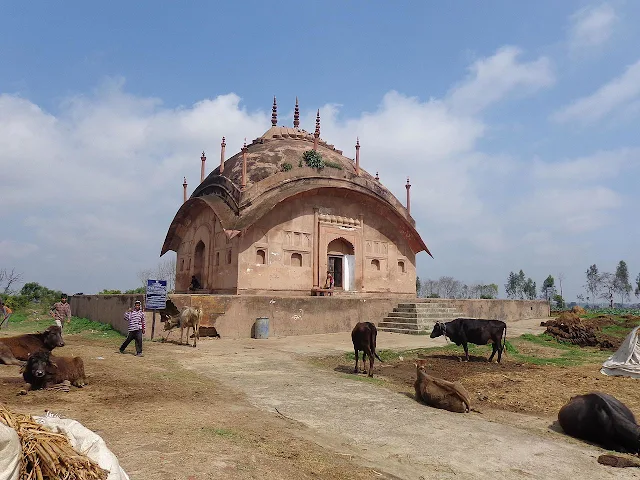Rashid Khan Ansari (Allahdad Khan), a grandson of Bayazid Ansari (Pir Roshan), was one of the important noble of Jehangir and Shah Jahan. When Jalala, the Bayazid Ansari's son, died in 1601 A.D, he was succeeded by his nephew Ahdad Khan, superseding the right to succession by his son Allahdad Khan. While Ahdad continued his resistance, Allahdad was won over by Jehangir. How Allahdad Khan changed side, is not clear , however in January 1615 A.D Jehangir records honoring him with a jeweled dagger for his becoming loyal . Jehangir kept on rewarding Allahdad Khan, but Allahdad was still suspicious of Jehangir's real intentions : one of the reasons might have been the fact that his son Jalal was still kept as hostage at the imperial court. Allahdad Khan rebelled, but shortly afterwards he surrendered at the instance of Khan-i-Dauran , he was given the title of Khan and promoted to the rank of 2,000 Zat and 1,000 Sawar. Hereafter Allahdad continued to serve Jehangir and Shah Jahan with loyalty and devotion. He was given the title of Rashid Khan in September 1617 by which he is known generally.
After ascending the throne, Shah Jahan conferred on him the rank of 3,000 Zat and 1,500 Sawar, and shortly afterwards he was deputed to pursue rebellious Jujhar Singh under the supreme command of Mahabat Khan. Being hotly pursued by the imperial army, and seeing no way out , Jujhar Singh submitted before Emperor and his offenses were pardoned. He was reinstated but some portions of his Jagir was confiscated and distributed among Mahabat Khan , Rashid Khan Ansari and others. Consequently at the occasion of Nauroz celebration, his rank was raised to 3,000 Zat and 2,000 Sawar. In 1631, he was sent to the Deccan with Azam Khan, the viceroy of Deccan. One day while Azam Khan was pitching his camp on the bank of Manjira river, he was surprised by Randola Khan. In this engagement a number of Mughal commander including Shahbaz Khan Ruhela were killed, and , Bahdur Khan and Yusuf Khan were made prisoner. However, Rashid Khan, who was severely wounded , succeeded in escaping from the battlefield.
In 1634, he was chosen to accompany Prince Shuja to besiege the fort of Parenda , though Parenda campaign was unsuccessful but Rashid Khan Ansari gave ample proof of his military skill and received an increase of 1,000 Sawar , so that his mansab became 3,000 Zat and 3,000 Sawar. After Parenda campaign, he continued to serve in the Deccan in various capacity. Later on, in appreciation of his services in the Deccan, he was elevated to the rank of 4,000 Zat and 3,000 Sawar. The author of Zakhiratul-Khwanin writes that Rashid Khan rose into prominence for his sincerity and achievements in the frontier region . In Deccan , the prince didnt take any decision without consulting him. Rashid Khan set a good example of fine administration and rendered valuable service in suppressing the Marathas. He enjoyed the confidence of the Emperor and had a large following of Pashtuns. Mahabat Khan became apprehensive of some of his activities and represented to Shah Jahan that Rashid Khan had a strong Afghan following and was so endowed with intellect and courage that he might become presumptuous. He advised the Emperor to recall him from Deccan. He also suggested that Khan-i-Zaman should not be posted to the frontier region or Deccan as he was on friendly terms with Rashid Khan. Farid further adds that due to friendship of Khan-i-Zaman and Rashid Khan, Asaf Khan and Abdullah Khan were hostile to both of them. They apprehended that if the two joined together and rebelled, it would lead to a serious situation for the empire. Inspite of this mechanization , Rashid Khan continued to serve as a leading and loyal noble. He laid the foundation of Mau Rashidabad in modern Farrukhabad district and brought the refractory elements under his control. He died as subedar of Balaghat (Deccan) in 1648. His followers brought his body to Mau Rashidabad, where he is buried.
Rashid Khan's troops who took up their residence in Mau, were 900 Toyah horsemen, 600 Muhammadzai, 600 Orakzai, 400 Dilazak, 400 Ghilzai, 400 Khalil, 400 Khattak, 300 Mataniya, 200 Lohani, 200 Afridi, 100 Bangash, in all, including other tribes, about 15,000 fighting men.
References: (1) "Afghans and Shaikhzadas in the nobility of Shah Jahan" by Reyaz Ahmad Khan, (2) 'Notes on Afghanistan' by H.G.Raverty (3) 'History of the Pathans' by Haroon Rashid
 |
| Tomb of Rashid Khan Ansari at Mau Rashidabad, Kaimganj, Farrukhabad (U.P). |



No comments:
Post a Comment